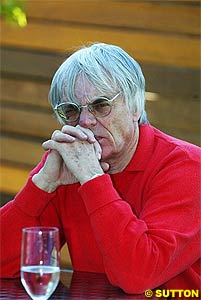Atlas F1 Magazine Writer
Fresh from the Formula One paddock
It was fascinating to watch. On Friday afternoon, shortly after the first day's practice runs, Bernie Ecclestone strolled through the Media Centre in Melbourne. He stopped to greet a journalist, then another. In no time at all a scrum had formed around the septuagenarian; in no time at all a media frenzy was in full swing.
He is, as we all are, aware that Ferrari either owns or has direct access to no less than three test tracks - Fiorano (literally on its doorstep), the Circuit Enzo e Dino Ferrari at Imola, and Mugello - and that this use, come sun, snow or sleet, is fettered only by a regulation banning testing in the four "working" days immediately before a Grand Prix. Certainly, the Scuderia's performance has not been handicapped by testing in recent times.
That testing, Ferrari's and others', has got totally out of hand is clear, with BAR-Honda's launch at Barcelona providing graphic illustration to just what degree. The place was both packed to the gills with transporters, trailers, motor homes and giant marquees decorated in all F1's colours, and, yet, was eerily quiet on that Sunday; on the one hand resembling a true Grand Prix paddock, on the other, hardly a soul was to be seen or heard as all waited for BAR's festivities to be run. No race rock at the Circuit de Catalunya that day, then, but all the trimmings playing to deserted stands and blind TV scaffolds.
Earlier on Melbourne Friday, during the official FIA Media Conference, Renault's Flavio Briatore had spoken of the "craziness" of testing, pointing out that, ten years ago, Michael and Schumacher and Benetton (under his leadership), won the championship on a half the present going rate. "Our business is racing, not testing," he said. Quite.
Certainly, pounding around deserted tracks with test teams - of up to 30 people each in Toyota's case - spread around Europe provides no visible return for sponsors, who are, logically, in Formula One not to see empty stands, but be seen by capacity crowds as often as possible. So, why not cut costs and combine their desires with increased revenues - which Ecclestone earns from race promoters through additional races, all-important trackside Paddock Club/ advertising/merchandising revenues?
In short, why not dump testing, and bump the calendar to, say 20 events?
How realistic is this? Well, Ecclestone went one further. His suggestion was to turn Grand Prix Fridays over to private testing (in public, though, if that makes any sense), making Saturday's full-on practice days, with Sunday mornings set aside for qualifying before the races proper in their normal slots. Do that 20 times a year, and you create 15% more revenues (on a 18-race calendar; 25% on 2003's 16 events), increase sponsor visibility, make F1 more of a "world" championship (two continents are wholly neglected by FIA championships - Africa and Antarctica, and, who knows, the South Pole may soon be granted a date...), provide 20 testing days as part of the "show", and play to more punters.
With F1 having gone from 16 to 18 events this year, just two additional events would be needed. At any one time Ecclestone is reputed to have upwards of 25 Grand Prix applications on his desk, so finding two tobacco-friendly countries should not pose insurmountable problems to the man. Where to slot them in? Logic dictates they be framed as bookends in climate-friendly venues, one in late February; the other at end-October.
That would leave November to finalise new cars, December and January to test them and early/mid-February to ship them. Twenty races would fill 38 test-less weeks. Subtract four for mandatory employee leave periods, and one for travel to the first Grand Prix. That leaves nine over the European winter. Surely enough in which to hone a car upon which millions have been blown during its gestation?
So, three birds - FOM revenues, cost-cutting, and spicing the "show" - slaughtered in one easy move, then? Only if all teams agree unanimously, and hell will freeze over before that. Why should Ferrari cancel its major performance advantage to spice F1? So, back to the negotiating table, then, and further cost spiraling until then.
Pity the FIA: when it introduces regulations at the request of team principals, whether sporting or technical, and they don't work, it (Formula One's controlling body) gets it in the neck. Saturday qualifying is a case in point, but it could as easily apply to Third (Friday) Drivers, or Friday Practice, or... or...
There were some small detailed discussions but it was quite an easy process. The new starting order in the first qualifying session was decided (upon, based on the official result of the previous Grand Prix) to make it less predictable. Also, the timing of the whole qualifying session will be tightened up. So, when a car crosses the line for its flying lap, the light in the pitlane will be green immediately (for the next car).
But, that the revised qualifying procedure needs urgent change became clear within just 30 seconds of the first car, in this case Ferrari's Rubens Barrichello after he won the last race (Japan 2003), hitting the track for the first pre-qualifying "out" lap of the 2004 season opener in Melbourne's Albert Circuit.
Had the Brazilian teammate to Michael Schumacher been quickest he would have waited 100 minutes (or so) before going out for his qualifying run proper. As it is, the Brazilian pre-qualified eighth, but that was down a track which had gotten "dirty" through various non-F1 activities between official Grand Prix sessions, and not driving or car ability.
With grid qualifying running order the reverse of pre-qualifying positions, he waited 92 minutes between first and last runs on Saturday afternoon. Now, that period is well-nigh six minutes longer than the entire 58-lap Australian Grand Prix endured the following day. And, with a driver like Schumacher earning an estimated $110 every minute of every day of 2004 ($60m for the year), any kid with Mickey Mouse's finest calculator could tabulate that Schumacher pocketed $10,000 just sitting around between runs. So, okay, Ferrari (or Shell or Marlboro or Vodafone) can well afford the sum, but is that really the point of qualifying?
At the other end of the scale both Minardi drivers, what with running pre-qualifying close to last, then bouncing straight out as slowest in the pre-session, enjoyed hardly a moment's rehydration, barely refuelled for the race. What if either's car (or, worse, both) needed quick spannering for safety's sake? If Ferraris can enjoy close on 90 minutes worth of attention (if required) why not tail enders - even in a meritocracy?
Clearly Qualifying needs change, and soon. But, to what? Last year's Friday/Saturday system was flawed due to FOM's worldwide television audience missing Friday sessions for obvious reasons and, in any event, going back to any previous system is tantamount to admission of failure. Could F1 ever admit to that? But, changing formats is failure dressed as lamb, and the sooner F1 does so the less sheepish it appears - particularly after a Sunday afternoon which saw one, at most, two, real manoeuvres.
On Saturday afternoon, immediately after Qualifying, McLaren's Ron Dennis suggested that F1 wait until the European season before introducing changes, but that overlooks the fact that the next two events are red-eye events for most of F1's world-wide audience. Would you get up at 5:00am or whatever to watch 37 flying laps in 90 minutes? In fact, would you even, during the Euro season, turn on the telly from the Saturday lunch table to watch such drawn-out affairs?
(It has been alleged that a VERY prominent team boss suggested that armchair fans avoid the tedium by switching on their television 30 minutes before the end of qualifying. Wonder how long his sponsors will enjoy coughing up a wasted $10,000 every fortnight?)
David Richards, boss of BAR-Honda, believes the answer lies in a Saturday afternoon 30-minute free-for-all session giving each driver, say, two flying laps, with times determining a subsequent Hot Lap shoot-out running order. Sure, those 30 minutes would be frenetic, but what if, say, Schumacher is disadvantaged by a Minardi driver? Or, maybe, a Sauber assists engine supplier Ferrari by holding up a Williams?
Then there are suggestions that a one-hour session - allowing a mandatory dozen laps per car as in days gone past, but requiring six per 30-minute session to prevent wise guys squeezing the whole lot into 20 minutes at the end - be run. The fastest times from these, then, should determine single lap sequence, which would decide grid positions. Sounds reasonable - F1 would have a hectic one hour session, plus a hot lap system. But, how to force cars to run at racing speeds in the face of regulations which all but mandate minimal track time and minimum revs until the last lap of the race?
Either way, F1's qualifying needs looking at, and PDQ at that. The teams and sponsors have the most to lose, so let them formulate a unanimous proposal and put it to the FIA for rapid implementation. As Otmar Szafnauer, Vice-President of Honda's F1 operation, said on Melbourne Sunday: "Used to be a time when qualifying was more exciting that the race proper. But, no more."
Formula One' short term challenge is not the stemming of the Red Tide, but, rather, the maximisation of potentially the most exciting 90 minutes of every Grand Prix weekend. Watch this space. Before Malaysia...

 Rapidly the major topic became cost-cutting, and Formula One's tsar reiterated his stance towards testing. "We need to cut back on private testing, and run 20 races," he said. Now, neither concept is a new drum - far from it - but the mere fact that the subject was discussed within minutes of Ferrari's Friday Fiesta speaks volumes, particularly as Ecclestone, who needs to increase his financial returns substantially following revelations that GPWC settlements require him to pay more (some say "double") to the teams, later referred to the Italian team's domination of the day (in retrospect, make that "weekend") as a "disaster"...
Rapidly the major topic became cost-cutting, and Formula One's tsar reiterated his stance towards testing. "We need to cut back on private testing, and run 20 races," he said. Now, neither concept is a new drum - far from it - but the mere fact that the subject was discussed within minutes of Ferrari's Friday Fiesta speaks volumes, particularly as Ecclestone, who needs to increase his financial returns substantially following revelations that GPWC settlements require him to pay more (some say "double") to the teams, later referred to the Italian team's domination of the day (in retrospect, make that "weekend") as a "disaster"...
 And, it really was the team bosses who came up with the strangest way in many a season (if not EVER) of wasting a Saturday afternoon. And, to prove it, herewith, verbatim, the FIA's official comment issued before the first qualifying sessions of 2004: "Again, just to be clear, this really was something that the team principals discussed at length in their own meetings and came to us and said this is what we think. And we said, fine, why not?"
And, it really was the team bosses who came up with the strangest way in many a season (if not EVER) of wasting a Saturday afternoon. And, to prove it, herewith, verbatim, the FIA's official comment issued before the first qualifying sessions of 2004: "Again, just to be clear, this really was something that the team principals discussed at length in their own meetings and came to us and said this is what we think. And we said, fine, why not?"
|
Contact the Author Contact the Editor |
Please Contact Us for permission to republish this or any other material from Atlas F1.
